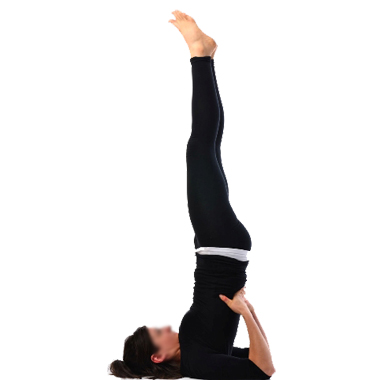
Posture:Sarvanga–asana–The Shoulder–stand Pose
Translation:The Sanskrit word sarvaanga means limb or body. sarvanga therefore translates as either "all-limb" or "whole-body posture". It is so named because of the benefit it provides to the entire body. It is commonly referred to as the "shoulder-stand" because one is essentially standing on one's shoulders.
Pronunciation:sar-vong-ah-sa-na
Difficulty:(5)
Instructions:
- Lie flat on the back in the shava-asana.
- Inhale through the nostrils. Place the palms face-down on the floor. Keeping the hips on the floor, bend the knees and bring them up toward the stomach while exhaling.
- Inhale slowly through the nostrils, press down on the hands and lift the torso from the waist up off the floor, arching the spine backwards and straightening the arms. Keep the hips on the floor.
- Inhale, then while exhaling, raise the legs straight up perpendicular to the floor. You may support your hips with your hands or leave the arms flat on the floor, whichever is most comfortable.
- The legs should be together with the knees straight and toes pointed straight up. Keep the head straight without turning it to either side. The chin should be pressed against the chest.
- Breath gently through the nostrils while the posture is held.
- Reverse the steps to return to the shava-asana.
Comments:
The sarvanga-asana is considered by many to be the most beneficial of all yoga postures. Because of its many benefits, if you find that your time is limited in the course of Yoga practice at home, it is recommended to place special emphasis on the sarvanga-asana.
When performed in the morning the sarvanga-asana relieves fatigue caused by sleeping too much or too little and when practiced in the evening it helps to promote deep, restful sleep. It strengthens the back and helps to relieve lower back pain.
The increased blood flow to the head and upper body helps to heal many disorders such as headaches, nasal congestion and sore throats. The entire endocrine, digestive, nervous, and venous systems of the body are stimulated in ways that no form of diet or conventional exercise can perform.
Because the body is inverted a rich supply of oxygenated blood is sent to the organs and glands in the upper part of the body, such as the brain, thyroid and pituitary, and heart thereby stimulating them.
Pressure is relieved from the lower body extremities relieving pain and/or swelling of the feet and legs. The sarvanga-asana also provides great benefit to the abdominal organs helping to relieve gas and constipation and stimulate digestion.
Regular practice of this posture invigorates the mind and helps to calm the nervous system.
Duration/Repetitions:
Hold the sarvanga-asana anywhere from one to five minutes depending on comfort. Repeat the posture two or three times.

Variations:
There are two common variations to this posture. One is called the shalamba-sarvanga-asana. Sa means with and alamba means prop or support and refers to the use of the arms to support the legs and torso as they are inverted. The other variation is called the niralamba-sarvanga-sana. Nir means without and thus this variation is done without the support of the arms.


